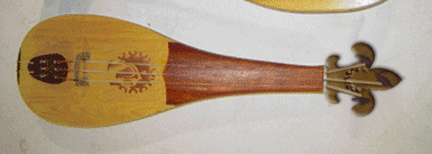
This is the envisioned rebec.
This project is going to be the
photo essay of the construction of one of these early rebecs.
There will be a few details glossed over on this instrument - I simply
want to have little more useful information to put on the page of
Nancy's rebec construction. So deatils like the tuning pegs,
which have already been covered in the Citole page, will be left out,
and other details like the bridge and tailpiece and tailpeg and saddle
will be on Nancy's page. That page will be started within a few
days, and completed quickly. I
hope that this project provides some inspiration for those who would
want to
venture into this craft themselves. And the best part - Conna
will be playing this thing for us. There is absolutely no
downside to this whole thing - and I love it when that happens.
Here's the first part of creating a rebec. I came across a suggestion while researching the construction of rebecs, that you could save yourself a lot of time and trouble, and get a very symetrical start, on a rebec if you were to take a block and turn it to basic shape, then cut it down the middle. I started to think of even better ways to do this, and decided to do the turning on a pair of blocks that had been faced and lightly glued together. Here's the steps.
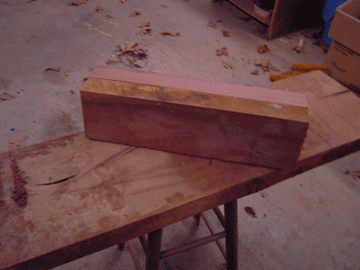
Here is a pair of walnut rebec blanks with a single white carpenter's glue line joining them right down the center. This glue is not meant to hold them for turning, merely to assure there is no slippage when I start turning the neck area. The blocks will be held together with plywood end caps which will also act as bearing surfaces for the lathe drive spur and tailstock center
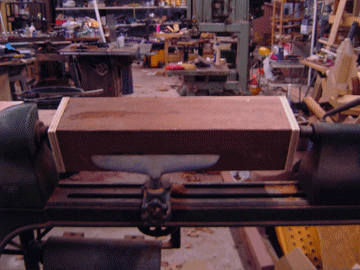
The set of blocks with the plywood caps , mounted in the lathe. This is a moderately heavy turning, and in well-seasoned walnut it requires sharp tools and a medium lathe speed.
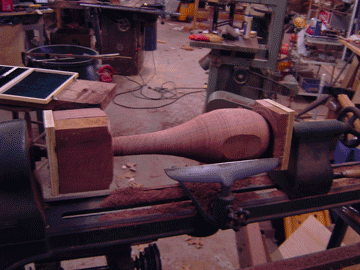
Here is the basic shape of the rebec body, with stock left full and square at the peghead end of the instrument (so that I can have a flat surface to use when I cut the outlines of the ornate peghead on this instrument.
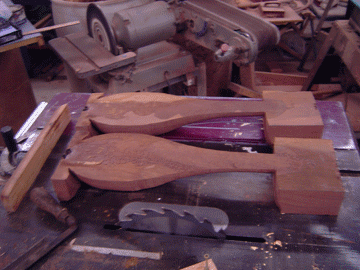
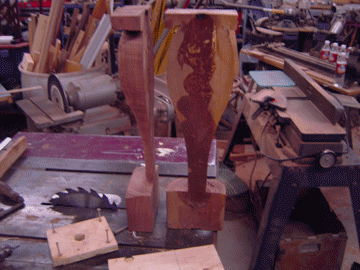
The halves of the turning, placed so you can see a plan and profile view. The streak down the center is the remaining glue. After hollowing the bowl and jointing the surfaces for the soundboard and fingerboard, and lowering the peg head, this glue line is inconsequential.
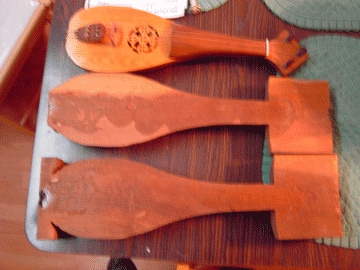
Here are the two rebec blanks along with my finished rebec. The blanks are very rough, but the idea for the turning is to get a lot of the gross stock removal done quickly, and symmetrically. Because now I can go directly to spokeshaves, planes and scrapers, instead of having to use drawknives, adzes and rasps, I can spend more time and effort on fine tuning the shape right off the bat. The turnings are oversized by a significant amount, I will end up taking almost 1/4 inch (and in some places a lot more) off everything but the neck thickness. I will get the final size and shape done before I hollow out the body and layout and cut the peghead.
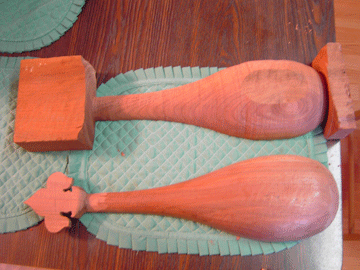
The body shape finalized, and the peghead cut to shape. A little work with scrapers and it will be ready for finish.
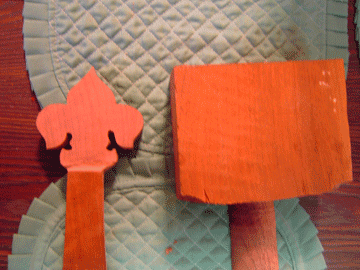
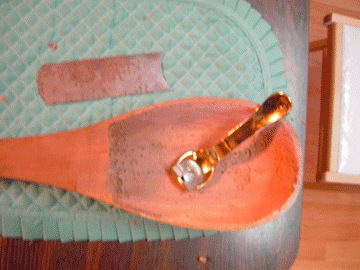
I rough-hollowed the bowl with forstner bits set to bottom out about 3/8 inch, then I used a curved scraper and a tool called a spoon plane to take the wall thickness down to about 1/8 inch in thickness.
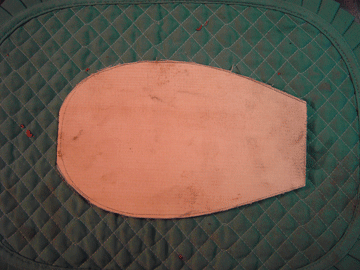
Here is the rough-cut soundboard - walnut dust fingerprints and all. This is 1/4 inch carpathian spruce (red grained), the same as I used on my citole. Next step is to transfer and cut the rosette and mate the body and soundboard.
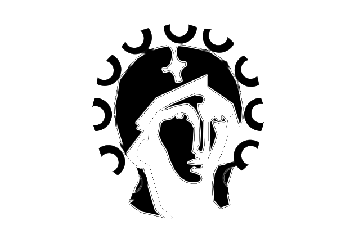
Here is the pattern for the rosette - remove the black. It was developed from an 11th century icon of Mary. It will be pierced into the soundboard, at about 2 1/2 inch in diameter.

I have pierced the rosette and thinned the soundboard, and glued it to the body. It came out quite well for what it is - a monochrome conversion in material removal taken from an 11th century icon. I hope Mary would be pleased to have a likeness of her on a musical instrument - few things can communicate peace and love like music, so I think she would be OK with it.
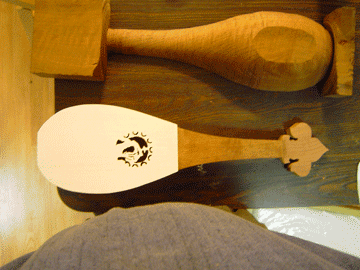
Top view of the instrument as of 10pm Thursday night - I will still be able to add the fingerboard tonight and that will leave only a few bits for tomorrow - less than I had left on my instrument when I showed up to Blood of Heroes with it unfinished. Compare it with the artist concept shown below. I think it is turning out remarkably like the concept. I did 'beef up' the fleur peghead, because I wanted to make sure I had the strength in the peghead to handle the strings. It is probably overkill, but as I don't have a lot of experience, better safe than sorry I say. Besides, I think the bigger fleur looks better, more appropriate. I will not be able to take any more pictures tonight, as pictures of an instrument covered in clamps and tape and such aren't really appealing. More photos tomorrow.

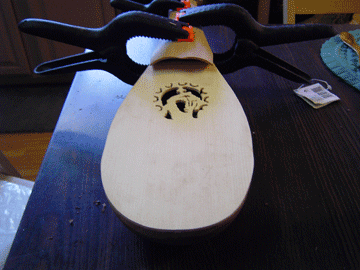
So I couldn't resist - there is something about publishing pictures at such a rapid rate, and showing progress like I have been able to make on this instrument, that just motivates me. So here is a view of the rebec, with the soundboard trimmed and thinned, and the fingerboard in place (clamps and all).
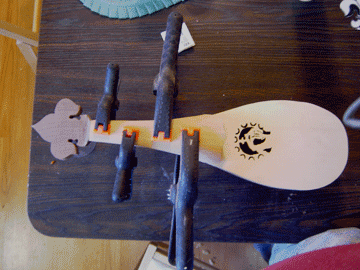
Here is a top view of the layout. In about an hour the glue will have dried enough that I can take the clamps off and do the final shaping of the fingerboard, and then I will add the saddle, the nut, and drill for the pegs. Then it's off to oil finishing.
I don't think there will be a problem with getting this thing delivered tomorrow (Saturday, December 3) at Kris Kinder. Find me or Conna to see the thing in person.
More pictures later this afternoon.
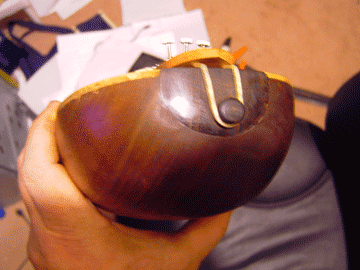
The saddle, of Macassar ebony. Keeps the tailgut from cutting into the spruce soundboard. One of the most difficult things is to get a good mating surface between materials of such different densities as ebony and walnut. This came out pretty good, of course you can see all the surface imperfections - it's shiny black! The tailpin is also ebony.
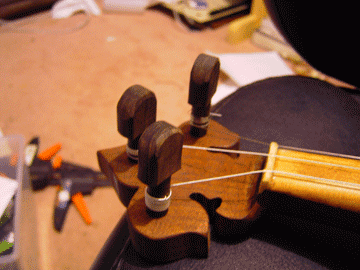
Tuning pins turned and in place. The pins are Macassar ebony, with a 5 degree taper. It is fun to work with this ebony, it machines well on a standard machinist lathe, which lets me cut a precise taper.
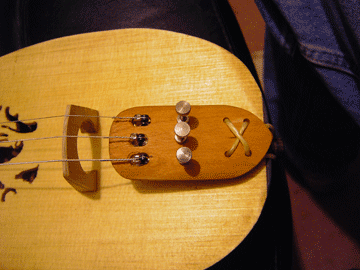
Here is the tailpiece - with fine tuners. It is cherry to match the fingerboard. The bridge is maple. The instrument is the loudest of the three yet.
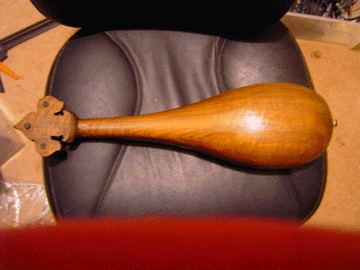
A bottom view of the completed rebec - the oil made the walnut beautiful. It is really much darker than this picture shows
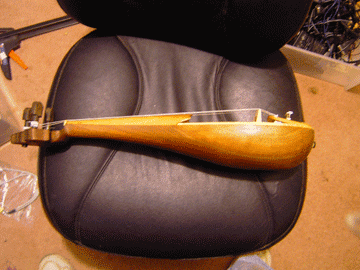
Side view, strung and ready to go. The cherry fingerboard and tailpiece really set off this instrument. It actually turned out better than I had hoped.
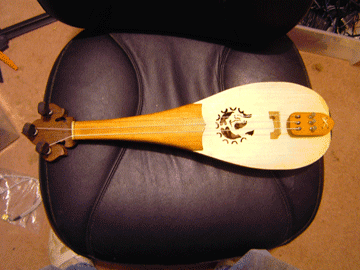
And the money shot, so to speak. The top view of the completed instrument ready for delivery. I did not have enough time to carve the laurel leaves into the peghead, but I will do that later when I have an afternoon with the instrument, perhaps at a Lilies or something.
Thus ends the saga of the 2 1/2 day rebec. It is really a fun instrument, and I have a feeling that it will make it's new owner happy.
Here's the first part of creating a rebec. I came across a suggestion while researching the construction of rebecs, that you could save yourself a lot of time and trouble, and get a very symetrical start, on a rebec if you were to take a block and turn it to basic shape, then cut it down the middle. I started to think of even better ways to do this, and decided to do the turning on a pair of blocks that had been faced and lightly glued together. Here's the steps.

Here is a pair of walnut rebec blanks with a single white carpenter's glue line joining them right down the center. This glue is not meant to hold them for turning, merely to assure there is no slippage when I start turning the neck area. The blocks will be held together with plywood end caps which will also act as bearing surfaces for the lathe drive spur and tailstock center

The set of blocks with the plywood caps , mounted in the lathe. This is a moderately heavy turning, and in well-seasoned walnut it requires sharp tools and a medium lathe speed.

Here is the basic shape of the rebec body, with stock left full and square at the peghead end of the instrument (so that I can have a flat surface to use when I cut the outlines of the ornate peghead on this instrument.

After removing the turning from the
lathe, and removing the plywood caps, I used an old, dull drawknife as
a splitting froe, wedging between the pieces and breaking the glue
line. Thus, a pair of rebecs is conceived. The second of
this set is going to Nancy, Pavel's music teacher. It will have a
few different features from the rest, as it will be a slightly later
period rebec, but for the most part construction will be identical to
this one. And differences will be documented on the web page for
Nancy's rebec.

The halves of the turning, placed so you can see a plan and profile view. The streak down the center is the remaining glue. After hollowing the bowl and jointing the surfaces for the soundboard and fingerboard, and lowering the peg head, this glue line is inconsequential.

Here are the two rebec blanks along with my finished rebec. The blanks are very rough, but the idea for the turning is to get a lot of the gross stock removal done quickly, and symmetrically. Because now I can go directly to spokeshaves, planes and scrapers, instead of having to use drawknives, adzes and rasps, I can spend more time and effort on fine tuning the shape right off the bat. The turnings are oversized by a significant amount, I will end up taking almost 1/4 inch (and in some places a lot more) off everything but the neck thickness. I will get the final size and shape done before I hollow out the body and layout and cut the peghead.

The body shape finalized, and the peghead cut to shape. A little work with scrapers and it will be ready for finish.

Here is the top view of the fleur
tuning peg head. Some relief of the edges, a carving of a laurel
leaf, and some tapered holes, and this end of the thing will be ready
for finish.

I rough-hollowed the bowl with forstner bits set to bottom out about 3/8 inch, then I used a curved scraper and a tool called a spoon plane to take the wall thickness down to about 1/8 inch in thickness.

Here is the rough-cut soundboard - walnut dust fingerprints and all. This is 1/4 inch carpathian spruce (red grained), the same as I used on my citole. Next step is to transfer and cut the rosette and mate the body and soundboard.

Here is the pattern for the rosette - remove the black. It was developed from an 11th century icon of Mary. It will be pierced into the soundboard, at about 2 1/2 inch in diameter.

I have pierced the rosette and thinned the soundboard, and glued it to the body. It came out quite well for what it is - a monochrome conversion in material removal taken from an 11th century icon. I hope Mary would be pleased to have a likeness of her on a musical instrument - few things can communicate peace and love like music, so I think she would be OK with it.

Top view of the instrument as of 10pm Thursday night - I will still be able to add the fingerboard tonight and that will leave only a few bits for tomorrow - less than I had left on my instrument when I showed up to Blood of Heroes with it unfinished. Compare it with the artist concept shown below. I think it is turning out remarkably like the concept. I did 'beef up' the fleur peghead, because I wanted to make sure I had the strength in the peghead to handle the strings. It is probably overkill, but as I don't have a lot of experience, better safe than sorry I say. Besides, I think the bigger fleur looks better, more appropriate. I will not be able to take any more pictures tonight, as pictures of an instrument covered in clamps and tape and such aren't really appealing. More photos tomorrow.


So I couldn't resist - there is something about publishing pictures at such a rapid rate, and showing progress like I have been able to make on this instrument, that just motivates me. So here is a view of the rebec, with the soundboard trimmed and thinned, and the fingerboard in place (clamps and all).

Here is a top view of the layout. In about an hour the glue will have dried enough that I can take the clamps off and do the final shaping of the fingerboard, and then I will add the saddle, the nut, and drill for the pegs. Then it's off to oil finishing.
I don't think there will be a problem with getting this thing delivered tomorrow (Saturday, December 3) at Kris Kinder. Find me or Conna to see the thing in person.
More pictures later this afternoon.

The saddle, of Macassar ebony. Keeps the tailgut from cutting into the spruce soundboard. One of the most difficult things is to get a good mating surface between materials of such different densities as ebony and walnut. This came out pretty good, of course you can see all the surface imperfections - it's shiny black! The tailpin is also ebony.

Tuning pins turned and in place. The pins are Macassar ebony, with a 5 degree taper. It is fun to work with this ebony, it machines well on a standard machinist lathe, which lets me cut a precise taper.

Here is the tailpiece - with fine tuners. It is cherry to match the fingerboard. The bridge is maple. The instrument is the loudest of the three yet.

A bottom view of the completed rebec - the oil made the walnut beautiful. It is really much darker than this picture shows

Side view, strung and ready to go. The cherry fingerboard and tailpiece really set off this instrument. It actually turned out better than I had hoped.

And the money shot, so to speak. The top view of the completed instrument ready for delivery. I did not have enough time to carve the laurel leaves into the peghead, but I will do that later when I have an afternoon with the instrument, perhaps at a Lilies or something.
Thus ends the saga of the 2 1/2 day rebec. It is really a fun instrument, and I have a feeling that it will make it's new owner happy.
